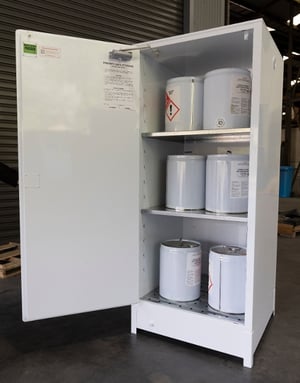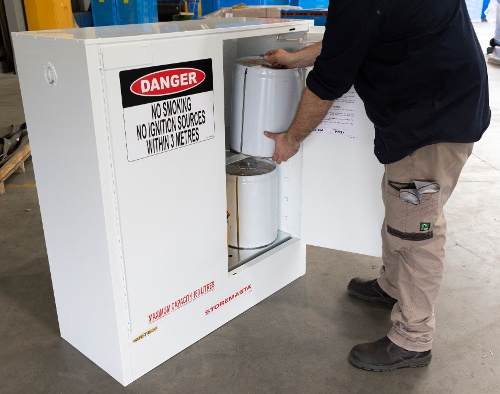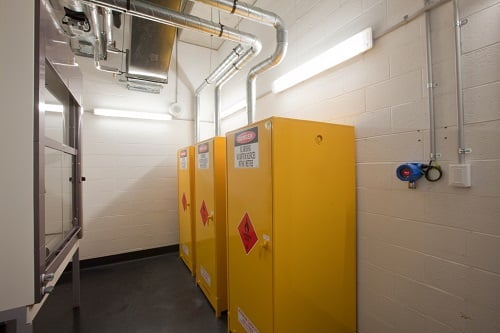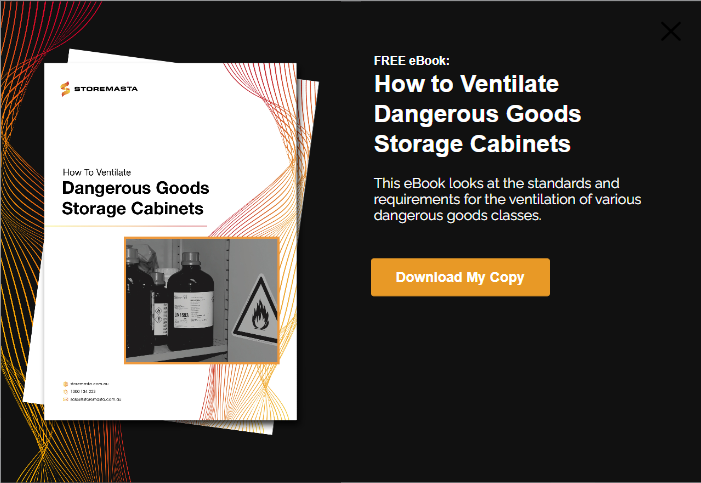If you’re storing hazardous chemicals or dangerous goods, one compliance box that you’ll have to tick is making sure the air quality of your work environment is safe for your workers. However, this consideration is not quite as simple as it first may appear, due to the many variables that can affect the level of airborne contaminants in a chemical store. When housing chemicals indoors in a compliant chemical storage cabinet, you are reducing a range of risks from hazardous spillage to the dangerous reaction of incompatible substances. However, there are some circumstances where your cabinet may be creating an environment that has a concentration of harmful airborne contaminants (ie. vapours, gases, mist, fumes, dust etc) that can be dangerous to the health of your workers.
In this post, we’ll explain what you need to do to determine if the airborne contaminants in your stores are of a safe level. We’ll also detail why cabinets don’t offer natural ventilation and may require, in specific circumstances, the installation of a mechanical ventilation system.
But first, let’s get started by finding out what is legally required in regard to the monitoring and management of airborne concentration levels in the workplace.
What Do The WHS Regulations Say?
In Section 49 of the Model WHS Regulations 2021, it explains that:
A person conducting a business or undertaking at a workplace must ensure that no person at the workplace is exposed to a substance or mixture in an airborne concentration that exceeds the exposure standard for the substance or mixture.
Maximum penalty: In the case of an individual—$6 000.
In the case of a body corporate—$30 000.
In Section 50, the Regulations state that the monitoring of airborne contaminant levels must be carried out if the exposure standard applies to the particular chemical substance or mixture that you’re storing.
Your cabinet should not emit dangerous concentrations of harmful vapours. Stores must be monitored and managed to ensure a safe working environment.
You’re obliged to determine if the substance or mixture exceeds the relevant exposure standard, or you need to monitor concentration levels to determine if there is a risk to human health.
REMEMBER: Any person who conducts a business or undertaking must eliminate health and safety risks, so far as is reasonably practicable. If the risks can’t be eliminated, they must be minimised. This is a requirement under WHS Regulations.
Workplace Exposure Limits
Safe Work Australia’s workplace exposure standards for airborne contaminants is your go-to document for determining if the chemicals you’re storing have legal limits for hazardous gases, vapours and particulate contaminant concentrations.
If you do determine that the workplace exposure standards apply to your chemicals, then you must reference the list of exposure standards to determine the legal limits for airborne contaminants in the breathing zone of workers.
IMPORTANT: The breathing zone of workers is defined in the exposure standards as a hemisphere of 300mm radius, which extends from in front of a worker’s face – measured from the midpoint of an imaginary line joining the ears.
The workplace exposure standards reiterates that you’re legally required, under Australian Work Health and Safety regulations, to not only manage the risks from airborne contaminants, but to monitor the levels in your workplace. This means that this is an ongoing process to monitor and manage the risks posed by the storage of hazardous chemicals which emit airborne contaminants in the breathing zone of workers.
How Do You Measure Airborne Contaminants?
The exposure standard can be measured in three forms:
- 8 hour time weighted average (TWA) - the maximum average airborne concentration of a substance when calculated over an 8 hour working day, for a 5 day working week.
- Peak limitation - a maximum or peak airborne concentration of a substance determined over the shortest analytically practicable period of time - which does not exceed 15 min.
- Short term exposure limit (STEL) - the time weighted average maximum airborne concentration of a substance calculated over 15 min.
The list of exposure standards details a comprehensive range of chemicals with the corresponding legal limits for hazardous airborne contaminant concentrations. This list is broken into key sections for consideration, including the peak limitation, TWA (time weighted average), the STEL (short term exposure limit) and the advisory carcinogen category.
Regardless of how you choose to measure the level of airborne contaminants, the list details the are specific limits that your workplace must fall within. If these are exceeded, you must immediately manage the situation by reducing the health and safety risks to your workers.
For example, the commonly used chemical, acetone, has a TWA of 500ppm/1185mg/m3; a STEL of 1000ppm/2375mg/m3 and no listing for advisory carcinogens. Therefore, depending on whether you’re measuring your airborne contaminants in TWA or STEL, you will have to monitor the airborne contaminants of your acetone chemicals – and keep the concentration levels below the stated limits.
To adequately measure the chemical concentrations in your workplace, you may need to consult with an industry expert. This could include working with a toxicologist or occupational hygienist who can assist you with monitoring and managing the airborne contaminant levels.
What To Do If You Exceed The Limits
There are some key ways to quickly reduce the concentration of hazardous gases and vapours in your indoor cabinets.
Immediate ways that you can reduce airborne contaminant levels in your store may include:
- Ensuring that all chemical packages are closed
- Placing lids back on chemical packages
- Checking that packages aren’t split or leaking
- Purchasing new container with secure lids
- Cleaning out the spill bunding of the cabinet
- Wiping down the packages to reduce chemical residue
- Cleaning out the cabinet to minimise harmful residue
- Reducing the volume of chemicals in the cabinet
- Moving suitable chemicals to an outdoor store
However, if these simple suggestions don’t effectively reduce the concentration of hazardous chemical vapours and gases in your indoor chemical storage cabinet, then you must consider the installation of a mechanical ventilation system.
Why Would A Cabinet Require Mechanical Ventilation?
Put simply, an indoor cabinet would require a compliant mechanical ventilation system if the level of airborne contaminants exceeds the legal limits, as specified in the workplace exposure standards.
High concentrations of hazardous gases and vapours can adversely affect the health of workers, which will result in health and safety issues.
Health issues could include:
- Nausea
- Fainting
- Breathing problems
- Asphyxiation
- Intoxication
- Poisoning
- Fatalities
As the health and safety of your workers is your legal obligation under WHS Regulations, if you don’t adequately monitor and maintain the air quality in your workplace, you may be putting your organisation at risk of non-compliance.
However, there is an additional reason why your cabinet would require mechanical ventilation — and this is determined by the Australian Standards.
Australian Standards
The Australian Standards offers detailed guidance for the storage and handling of each class of dangerous goods. These documents are an essential tool when it comes to achieving and maintaining workplace chemical compliance.
The Standards will offer specific details about the construction of your chemical stores, as well as how they are used and maintained.
Check the Australian Standards to determine if your stored chemicals should be kept in a cabinet with mechanical ventilation.
One key point within these Standards is the need for ventilation in chemical stores. And while not all dangerous goods are required to have ventilation in indoor chemical cabinets, there are some chemical classes that do require the installation of a ventilation system.
Here is a quick breakdown of which classes require ventilation. However, keep in mind that the airborne contaminant levels must still comply with the legal limits as explained in the workplace exposure standards:
- Class 1 Explosives – no ventilation system should be installed on internal portable explosives magazines (ie. explosive storage cabinets)
- Class 3 Flammable Liquids – no specific requirement for mechanical ventilation, however, you should reference the workplace exposure standards
- Class 4 Flammable Solids - no specific requirement for mechanical ventilation, however, you should reference the workplace exposure standards
- Class 5.1 Oxidizing Agents – compliant mechanical ventilation is a mandatory requirement of the Standard for oxidizing agents
- Class 5.2 Organic Peroxides – compliant mechanical ventilation is a mandatory requirement of the Standard for organic peroxides
- Class 6 Toxic Substances - no specific requirement for mechanical ventilation, however, you should reference the workplace exposure standards
- Class 8 Corrosive Substances - no specific requirement for mechanical ventilation, however, you should reference the workplace exposure standards
Why Don’t Cabinets Have Natural Ventilation?
So, why don’t indoor chemical cabinets just have natural ventilation systems?
Indoor chemical cabinets are constructed to contain hazardous vapours — not disperse them — with construction features including a double-walled sheet steel construction and self-closing, tight-fitting cabinet doors. These features are built-into indoor cabinets to prevent chemical spillage and vapour emissions, as well as offering protection against flames and excessive heat.

While your indoor cabinet may offer containment for spillage and vapours, this can lead to issues with dangerous airborne contaminant levels.
And while this is essential for protection people, property and the environment from chemical risk, there is the possibility that your indoor cabinet may be encapsulating higher levels of hazardous gases and vapours. This can cause your staff acute or chronic health issues when they open the cabinet doors to access chemicals.
However, outdoor chemical stores are designed and constructed with two walls of louvres to assist with the dispersion of hazardous vapours into the surrounding environment. They are designed and constructed in an entirely different way to your indoor storage cabinets. This is because they are kept in the outdoor environment and must be strong enough to shield the stored chemicals from environmental conditions.
Understanding Mechanical Ventilation Systems
For the health and safety of your team — as well as the compliance of your organisation — it’s vital that workplaces understand the legal guidelines that apply to airborne contaminants. It’s also equally important to understand the requirements of the Australian Standard that relates to the dangerous goods class of chemicals that you’re storing.
To find out more about mechanical ventilation, why not download our free eBook. How To Ventilate Dangerous Goods Storage Cabinets is our definitive guide on determining the ventilation requirements for your indoor store. Grab your copy of our eBook today by simply clicking on the image below.

Living life by the 4 C’s of marketing – communication, coffee, compliance… and more coffee – Leisa Andersen is Storemasta’s Content Marketing Manager. When she’s not writing, you’ll find her enjoying all the good things in life, including shopping, travel and gluten free donuts.


